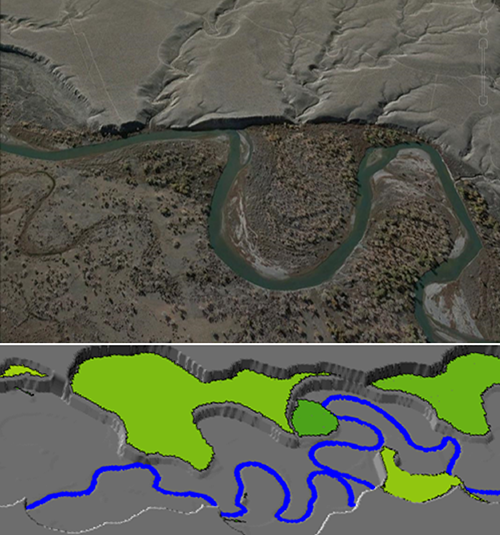Source: Journal of Geophysical Research: Earth Surface
Many rivers erode laterally across their valleys to form broad, flat areas. Because rivers also cut downward, these flats can be stranded above the river level as terraces. It is often argued that a river must cut down quickly in a process driven by external forces like tectonics, sea level, and climate change to form a terrace. Therefore, studying terraces might clue researchers in to a record of geologic history spanning thousands of years.
Some studies suggest that terraces form instead under steady conditions when a river, cutting down at a constant rate, sweeps erratically across its valley. In this scenario, terraces, rather than serving as indicators of past climate change, would be but chance remnants of river erosion.

In a new study, Limaye and Lamb test these scenarios using a numerical model. In the model, a meandering river migrated across its valley while cutting downward. The researchers report that this model can produce extensive terraces at a frequency that overlaps with timescales for orbitally driven climate change. The ratio of river downcutting to lateral erosion and the presence of bedrock that limits lateral erosion both influence terrace formation. In some cases, the ages and shapes of the modeled terraces resembled terraces in five North American River valleys across a range of geologic environments, including the Colorado River (Texas) and the Wind River (Wyoming).
The study also found that for cases with episodic river downcutting driven by climate change, lateral erosion could complicate the terrace record by creating more terraces than downcutting episodes and, conversely, by destroying existing terraces. Terrace formation by chance, on the other hand, occurs for a well-defined range of erosion rates. Using this information, the authors offer a guide for targeting terraces more likely to record past climate change. (Journal of Geophysical Research: Earth Surface, doi:10.1002/2014JF003392, 2016)
—Wudan Yan, Freelance Writer
Citation:
Yan, W. (2016), A river runs through it, but why?, Eos, 97, https://doi.org/10.1029/2016EO053975. Published on 14 June 2016.
Text © 2016. The authors. CC BY-NC-ND 3.0
Except where otherwise noted, images are subject to copyright. Any reuse without express permission from the copyright owner is prohibited.

